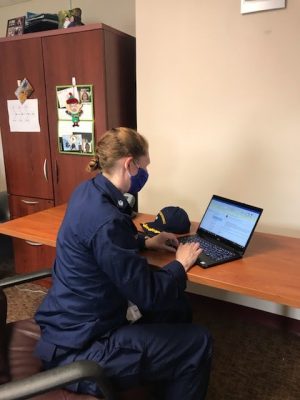Diving into animation
As part of a series to inspire current Jefferson students about future career paths, tjTODAY interviewed a 3D game animator

Murrie works with 3D animation software like the one pictured to create characters for her various projects.
February 27, 2021
Note: This article is part of a series where we ask Jefferson alumni to describe a day in the life of their careers, to help Jefferson students explore and evaluate different career paths and options.
Going to Jefferson equals a career in science and technology? Well, not necessarily. Many Jefferson students are interested in pursuing more creative jobs, but are hesitant due to parental pressures, or a lack of artistic experience. For these students and others, working as an animator might be the perfect career choice.
Martha Murrie, a Jefferson alumna and 3D animator working on game design, shared what a day in her life is like to educate students on the specifics of the career.
“[My day begins with] a morning meeting, we look at the combat that we’ve been working on with our game designers, and then we kind of make some notes about stuff we need to work on. and kind of set our priorities,”Murrie said. “From there, we go into an animation review where we review all of our work, and then, we basically go about our day.”
What going about their day looks like depends a lot on the type of animator in question, and the types of techniques they’re working with.
“I specifically am a character animator, so I make characters move. We opt to do motion capture [animation], where somebody wears a motion capture suit, and they go through and perform some actions that we had determined beforehand what we want them to do,” Murrie said. “It kind of helps us get further along into the animation process, since with video games, we [also] have much tighter deadlines.”
Murrie’s work does vary from other animation careers; while she works with live models, other animators work from different inspiration.
“[My work is] different from someone at Pixar [for example]. So someone at Pixar is doing keyframe animation, so most likely, someone would work out like a storyboard to figure out what they want the story to look like,” Murrie said. “And then the animator goes through and looks at that and says, ‘Okay, how can I, like make this a good performance?’ So then they are out there shooting their own video reference and putting in their own poses, so they’re more like crafting the performance from scratch.”
Murrie also discussed how these 3D animations differ from 2D animation. She mentioned that 3D animation does not require drawing skills, which may be comforting to some.
“All of [these types of 3D animations are] going to be vastly different from somebody working on, say, TV, who’s doing 2D animation. They would go through storyboards [that have] been already planned out for you, though I don’t know too much about 2D animation because I’m not so great at drawing– that’s not my strength,” Murrie said.
Regardless of the type of animation in question, Murrie believes that the career is a perfect fusion of art and technology, as well as problem solving.
“Especially in today’s world, there are so many endeavors that involve both art and technology– and animation being a perfect example.” Murrie said. “You’ll get some animators that are definitely more computer oriented, and we definitely need people like that because you’re on a computer eight hours a day, you gotta be good with troubleshooting and being able to figure out why your program is working the way it is, or anything like that. But I think probably most animators are more artists. So sometimes it’s a little bit more about overcoming technological challenges, and figuring out how to animate despite whatever it might be getting in your way.”
Classes at Jefferson helped Murrie on her journey to becoming an animator.
“When I went to TJ, video tech was still one of the tech labs, and that’s what I did. So I’ve always kind of been interested in entertainment technology. Unfortunately, I think they took that away.” Murrie said, “The rest of my background at TJ, especially taking computer science, was helpful [too]. Not that I do any programming, but there is some scripting that animators do to help with repetitive processes. Like if there’s something that you’re doing and one of your animation files over and over and over again, you can write a script that will do it for you. So I do think that technology, and the kind of stuff that we learned at TJ is always helpful, even in a field that is mostly artistic.”
Murrie recommended some classes and programs for people who are interested in the career to take and experiment with the field of animation.
“There are some free programs that you can try. anyone that’s interested in animation. One of them is called blender, and there are other programs like animsquad animschool, Ringling, all these online programs,” Murrie said. “I think that’s a good place to start just to see, if you like animation.”
Lastly, Murrie, who received further animation education through classes in community college, emphasized the importance of education in focusing one’s interests.
“I went to a community college for a couple semesters, and I just took a Maya (a type of animation software) class where I learned modeling, I learned some lighting, I learned animation, [and] I learned a little bit of rigging. I found that I was able to see which field I liked the best within 3D,” Murrie said. “I think that was really, really helpful in narrowing it down, because there’s so much to learn, and it can be hard to focus. So yeah, I highly recommend community college, or any sort of class that you can take. Always try to get a little bit of exposure to all the different options.”








